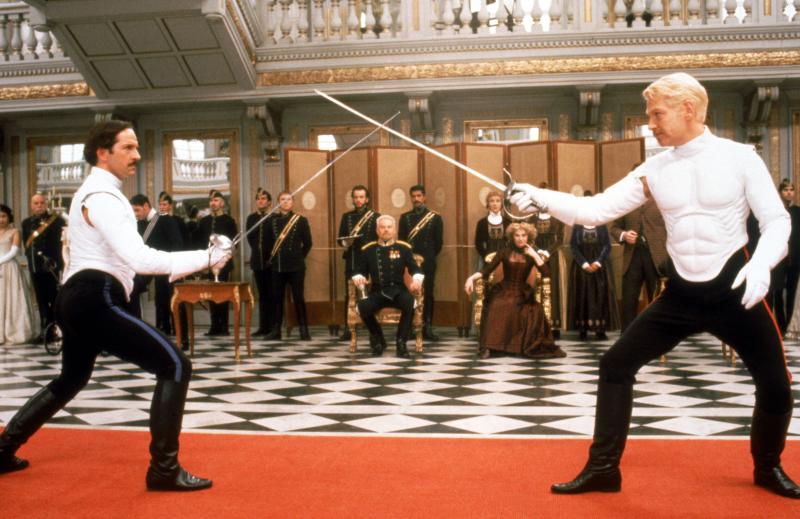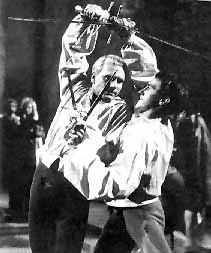theartsdesk Olympics: En Garde! Fencing on Stage and Screen | reviews, news & interviews
theartsdesk Olympics: En Garde! Fencing on Stage and Screen
theartsdesk Olympics: En Garde! Fencing on Stage and Screen
An esoteric sport finds its niche courtesy of Shakespeare

Is that a sabre you see before you? It could be if you’re talking any of multiple stage and screen versions of Hamlet, the Shakespeare play that puts centre-stage arguably the most esoteric of all Olympics activities: fencing. (Well, OK, beach volleyball is possibly just as rarefied, though it’s hard to imagine Hamlet and Laertes having much truck with that.)
Hamlet may in fact represent most culture vultures’ first (only?) exposure to a sport that seems to belong to a select few, bringing with it a self-enclosed language that left even the BBC flummoxed one recent evening as a commentator admitted that she had never before heard the verb “flunge”. Scrabble enthusiasts take note.
 Nor until this year’s Games had I clocked the difference between the epee, foil and sabre, though each apparently comes with specific rules of its own. What I can vouch for is that the parries and thrusts allowed by fencing make the heart race. Think back, for starters, on the swordplay of Laurence Olivier (pictured right) and Kenneth Branagh, the cinema’s two most formidable Danish princes: the first a noble Hamlet whose passion spilled over into some notably vivid aggression, the second a less romantic figure who made his rapier wit an extension of the thrusting implement itself.
Nor until this year’s Games had I clocked the difference between the epee, foil and sabre, though each apparently comes with specific rules of its own. What I can vouch for is that the parries and thrusts allowed by fencing make the heart race. Think back, for starters, on the swordplay of Laurence Olivier (pictured right) and Kenneth Branagh, the cinema’s two most formidable Danish princes: the first a noble Hamlet whose passion spilled over into some notably vivid aggression, the second a less romantic figure who made his rapier wit an extension of the thrusting implement itself.
In stage terms, I particularly recall the fevered interplay between Ralph Fiennes and a (very) pre-Homeland Damian Lewis in the Jonathan Kent-directed Hamlet that played the Hackney Empire and then Broadway in 1995, winning Fiennes a Tony Award. Keen, Fiennes told me at the time, for the play’s climactic duel to be “as pure as possible”, the two men’s face-off spilled well beyond the rectangular mat on the floor, weaving among the chairs of Claudius’s dismayed court. To up the ante, the foils were made of strengthened steel, not the more traditional weapons that had been deployed in the Peter Hall/Stephen Dillane Hamlet a season before.
Both productions owed their keen sense of daggers drawn to a fight director, William Hobbs, who knew his way around film as well, having put John Malkovich and Keanu Reeves (of all unlikely combatants) through their paces in Dangerous Liaisons, to cite just one of Hobbs's various credits; the Tim Roth film Rob Roy was another. But it’s the visceral charge of the stage combat between Fiennes and Lewis that to this day I still recall. “A hit, a very palpable hit,” cries the courtier Osric. In other words: gold medals all round.
Explore topics
Share this article
The future of Arts Journalism
You can stop theartsdesk.com closing!
We urgently need financing to survive. Our fundraising drive has thus far raised £49,000 but we need to reach £100,000 or we will be forced to close. Please contribute here: https://gofund.me/c3f6033d
And if you can forward this information to anyone who might assist, we’d be grateful.

Subscribe to theartsdesk.com
Thank you for continuing to read our work on theartsdesk.com. For unlimited access to every article in its entirety, including our archive of more than 15,000 pieces, we're asking for £5 per month or £40 per year. We feel it's a very good deal, and hope you do too.
To take a subscription now simply click here.
And if you're looking for that extra gift for a friend or family member, why not treat them to a theartsdesk.com gift subscription?
more Film
 One Battle After Another review - Paul Thomas Anderson satirises America's culture wars
Leonardo DiCaprio, Teyana Taylor, and Sean Penn star in a rollercoasting political thriller
One Battle After Another review - Paul Thomas Anderson satirises America's culture wars
Leonardo DiCaprio, Teyana Taylor, and Sean Penn star in a rollercoasting political thriller
 Steve review - educator in crisis
Cillian Murphy excels as a troubled headmaster working with delinquent boys
Steve review - educator in crisis
Cillian Murphy excels as a troubled headmaster working with delinquent boys
 Can I get a Witness? review - time to die before you get old
Ann Marie Fleming directs Sandra Oh in dystopian fantasy that fails to ignite
Can I get a Witness? review - time to die before you get old
Ann Marie Fleming directs Sandra Oh in dystopian fantasy that fails to ignite
 Happyend review - the kids are never alright
In this futuristic blackboard jungle everything is a bit too manicured
Happyend review - the kids are never alright
In this futuristic blackboard jungle everything is a bit too manicured
 Robert Redford (1936-2025)
The star was more admired within the screen trade than by the critics
Robert Redford (1936-2025)
The star was more admired within the screen trade than by the critics
 Blu-ray: The Sons of Great Bear
DEFA's first 'Red Western': a revisionist take on colonial expansion
Blu-ray: The Sons of Great Bear
DEFA's first 'Red Western': a revisionist take on colonial expansion
 Spinal Tap II: The End Continues review - comedy rock band fails to revive past glories
Belated satirical sequel runs out of gas
Spinal Tap II: The End Continues review - comedy rock band fails to revive past glories
Belated satirical sequel runs out of gas
 Downton Abbey: The Grand Finale review - an attemptedly elegiac final chapter haunted by its past
Noel Coward is a welcome visitor to the insular world of the hit series
Downton Abbey: The Grand Finale review - an attemptedly elegiac final chapter haunted by its past
Noel Coward is a welcome visitor to the insular world of the hit series
 Islands review - sunshine noir serves an ace
Sam Riley is the holiday resort tennis pro in over his head
Islands review - sunshine noir serves an ace
Sam Riley is the holiday resort tennis pro in over his head
 theartsdesk Q&A: actor Sam Riley on playing a washed-up loner in the thriller 'Islands'
The actor discusses his love of self-destructive characters and the problem with fame
theartsdesk Q&A: actor Sam Riley on playing a washed-up loner in the thriller 'Islands'
The actor discusses his love of self-destructive characters and the problem with fame
 Honey Don’t! review - film noir in the bright sun
A Coen brother with a blood-simple gumshoe caper
Honey Don’t! review - film noir in the bright sun
A Coen brother with a blood-simple gumshoe caper

Add comment